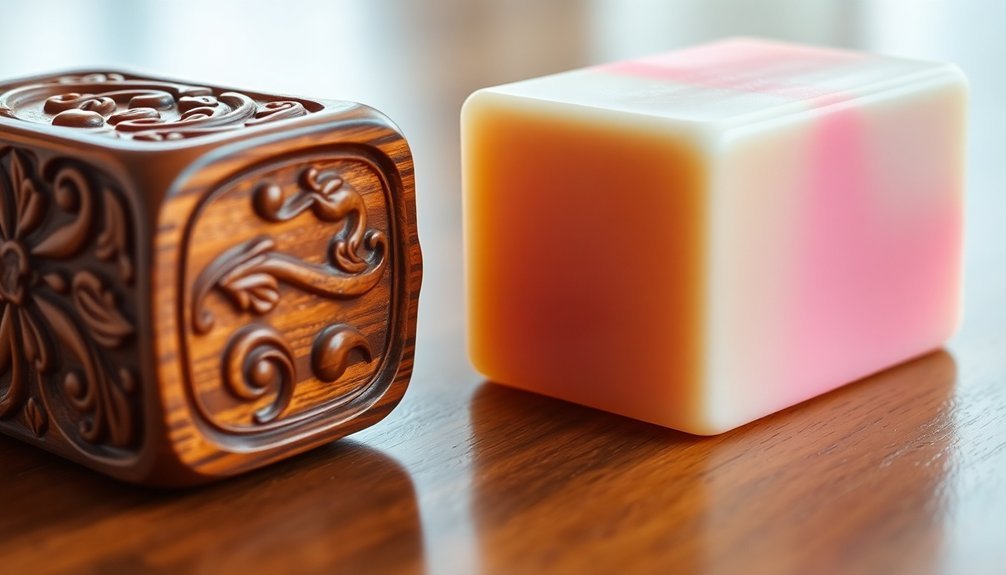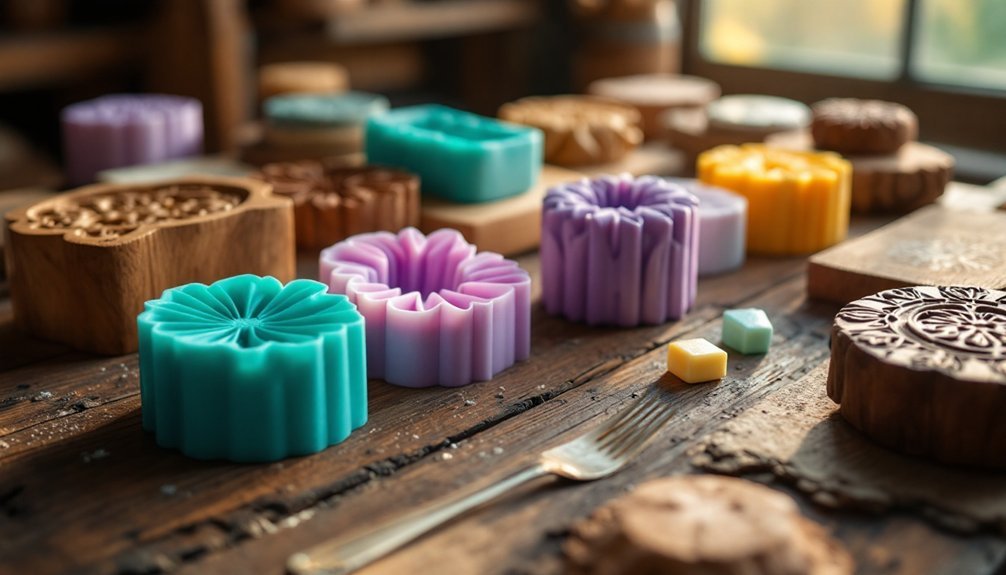When choosing soap molds, consider your specific needs. Wooden molds provide excellent insulation for promoting gel phase and vibrant colors, but require lining and careful maintenance. Silicone molds offer easy unmolding, intricate designs, and simple cleaning without warping concerns, though they cool faster and may need extra insulation for gel phase. Your decision depends on temperature control preferences, design complexity, and maintenance commitment. Below, you'll discover how each option impacts your finished soap quality.
Durability and Lifespan: How Wood and Silicone Molds Compare
When choosing between wood and silicone soap molds, durability becomes a key deciding factor for your investment.
Both options offer impressive longevity when properly maintained, but with different care requirements.
Silicone molds excel in durability, withstanding high temperatures and repeated use without degradation.
They're easy to clean with just warm water and dish soap, and their flexibility prevents damage during soap removal. To remove persistent scents or colors, you can effectively use rubbing alcohol as a cleaning agent.
You won't need to worry about warping or moisture damage.
Wood molds, while equally long-lasting, demand more attention.
You'll need to line them before each use, avoid submerging in water, and occasionally treat the wood with furniture polish.
However, they actually improve with age, becoming "seasoned" over time.
With proper care, both types will serve you for years.
The Insulation Factor: Temperature Control in Soap Making
Temperature control can make or break your soap's final appearance, with wood and silicone molds behaving quite differently in this regard.
Wood naturally insulates your soap mixture, promoting gel phase and creating vibrant colors, while silicone allows heat to dissipate quickly for more controlled designs. It's important to know that high temperatures in wood molds may lead to overheating and cracking if your recipe contains ingredients that saponify quickly, such as coconut oil.
You'll need to match your mold choice to your specific recipe requirements, considering whether you want the enhanced colors of gel phase with wood or the predictable cooling patterns offered by silicone.
Gel Phase Mastery
Many soap makers consider the gel phase to be their secret weapon for creating vibrant, glossy bars. This natural heating process occurs during saponification, with temperatures reaching up to 180°F, enhancing colors and reducing unmolding time.
Your mold choice greatly impacts gel phase management. Wood molds naturally insulate soap, promoting complete gel phase without additional effort.
Silicone molds, while offering easy release, require extra insulation using towels or blankets if you're aiming for gel phase. For best results, covering silicone molds and monitoring temperature after 30 minutes can ensure proper heat retention throughout the saponification process.
If you're working with milk-based or sugar-heavy recipes, you might want to avoid gel phase entirely to prevent scorching. In these cases, choose silicone and place your soap in the refrigerator after pouring.
Heat Retention Properties
Understanding heat retention lies at the heart of successful soap making.
Wooden molds naturally insulate your soap, maintaining heat longer and promoting gel phase development. This insulation allows your soap to cool gradually, which can enhance color vibrancy and texture.
Silicone molds, while flexible and user-friendly, conduct heat differently. Your soap will cool faster in silicone, which might be preferable if you're working with heat-sensitive additives or fragrances that could cause overheating. High-water soap formulations should especially consider using silicone molds to prevent the formation of silicone rash and minimize risk of overheating.
The size and shape of your mold also matter—larger batches retain more heat due to increased thermal mass, while soaps spread across a wide surface area cool more quickly.
If you're using the CP/OP method with oven temperatures between 175-200°F, wooden molds provide superior temperature stability, reducing the risk of those dreaded soap volcanoes.
Cooling Speed Benefits
The strategic control of cooling speeds forms the foundation of advanced soap making techniques.
When you choose between wood and silicone molds, you're actually selecting how quickly your soap will cool during saponification.
Wood molds naturally insulate your soap, slowing cooling and promoting gel phase for a uniform texture. This helps prevent lye pockets that can cause skin irritation.
Silicone, conversely, allows faster cooling—perfect when you want to avoid gel phase or preserve delicate colors.
Your working environment matters too. Room temperature influences cooling rates regardless of mold material. You should aim for temperatures below 110°F for ideal trace development and controlled saponification.
For complex designs or recipes with high saturated fats, consider how cooling speed affects the final product.
Ease of Unmolding and Soap Release Properties
You'll find unmolding soap considerably easier with silicone molds thanks to their flexible nature that allows you to bend and release your creation.
Wood molds require careful lining with freezer paper to prevent sticking, while silicone's non-stick surface naturally releases soap without additional preparation.
Though silicone offers convenience, wood molds might require longer curing times before unmolding, typically 24-48 hours compared to silicone's potential for earlier release. Many soapmakers add sodium lactate to expedite hardening when using silicone molds since soap typically takes longer to harden in them.
Flexible vs. Rigid Removal
Selecting between silicone and wooden soap molds often hinges on how easily you can release your finished product. Silicone offers flexibility that allows you to gently pull away the sides and pop out intricate designs without damage. Wood molds typically require proper lining but reward you with faster unmolding times. A side-by-side comparison clearly shows that soaps made in wood molds experience quicker unmolding under normal conditions.
| Feature | Silicone Molds | Wooden Molds |
|---|---|---|
| Unmolding Method | Gently pull sides away | Slide out after curing |
| Lining Needed | No | Yes (freezer paper) |
| Airlock Issues | Can occur | Rarely with proper lining |
| Release Speed | Slower | Faster |
| Surface Finish | Smooth, detailed | Dependent on liner quality |
When unmolding, silicone requires patience as you navigate potential airlocks, while wood's rigidity helps soap release more efficiently once properly cured.
Stick-Free Surface Benefits
Soapmakers cherish one unmistakable advantage of silicone molds: their naturally stick-free surface. This built-in non-stick property means your soap slides out cleanly without the hassle of lining molds with paper as required for wooden alternatives. You'll achieve a professional, glossy finish every time.
Breaking the airlock around your soap is essential for easy unmolding from silicone containers. Once released, your creations will display smooth surfaces that showcase your craftsmanship. The flexible material allows for gentle bending to help release even the most intricate soap designs without damage.
- No lining required—simply pour and set
- Easy cleanup with just soap and water
- Long-lasting durability with consistent release properties
- Versatile shape options for creative designs
For best results, verify your soap has fully hardened before unmolding to prevent sticking issues. Adding sodium lactate can speed up this process.
Unmolding Time Differences
While silicone molds offer excellent non-stick properties, the timing differences between wood and silicone unmolding deserve consideration.
Wood molds typically allow for faster unmolding as they're lined, letting you simply lift out your soap using the liner. You'll find this especially helpful when working with intricate designs. Using wooden soap molds with disassemblable sides or bottoms can make the removal process even more convenient for crafters.
Silicone molds, however, require breaking the airlock by gently pulling the flexible sides away from your soap—a process that often takes longer.
The insulation properties of wood help your soap reach gel phase more uniformly, which can affect release time positively.
With silicone, you'll need to be patient and wait until the soap has completely cooled and solidified.
Remember that your recipe and ambient temperature will influence unmolding times regardless of which material you choose.
Customization Options and Design Flexibility
When exploring the world of soap making, the customization options and design flexibility of your molds will dramatically impact your creative potential.
Wooden molds offer cost-effective customization with natural insulation benefits, while silicone provides unmatched design versatility with thermal resistance up to 200°C.
Wood delivers sustainability and longevity but requires lining, whereas silicone's flexibility guarantees easy soap release and allows for intricate detailing. Wood molds are excellent for insulating cold process soap, promoting faster saponification and better curing results.
Your choice ultimately depends on your creative vision and production needs.
- Wooden molds can be custom-built to specific sizes with renewable materials
- Silicone enables complex designs and professional-looking finishes
- Both materials offer long-term use, but with different maintenance requirements
- Silicone provides greater personalization options for unique, themed creations
Maintenance Requirements and Cleaning Considerations

Proper maintenance of your soap molds greatly impacts both their lifespan and the quality of your finished products.
Silicone molds require minimal upkeep—they're non-stick and don't need lining. Rinse them immediately after use with warm water and mild detergent, avoiding abrasive tools that could scratch the surface. For stubborn residue that won't rinse away, consider giving your silicone molds a gentle soak in white vinegar.
Wood molds demand more attention. You'll need to line them before each use and avoid water immersion which causes warping. Instead, wipe them with isopropyl alcohol to remove soap residue and check regularly for cracks.
For both types, use soft cloths and gentle tools during cleaning.
Store in cool, dry places away from direct sunlight. Regular inspections help you catch wear signs early, ensuring your molds remain functional for years to come.
Environmental Impact and Sustainability of Mold Materials
Beyond maintenance considerations, today's soap makers increasingly factor environmental impact into their mold choices.
When comparing sustainability, silicone generally outperforms wood and plastic options due to its recyclability, non-toxic composition, and remarkable durability that reduces replacement frequency.
While wooden molds offer natural insulation and customization benefits, they contribute to deforestation and require regular maintenance to extend their lifespan.
Wooden molds connect crafters to natural materials but come with environmental costs and ongoing upkeep requirements.
Silicone's initial higher cost is offset by its long-term value and environmental advantages. The slightly higher initial investment in quality silicone molds is justified by the significant long-term savings and reduced environmental impact over years of use.
- Made from non-toxic, BPA-free materials that won't leach chemicals into your soap
- Requires less energy during production compared to alternatives
- Can withstand hundreds of uses without significant degradation
- Fully recyclable at the end of its useful life
Frequently Asked Questions
Can Soap Molds Be Used for Other Crafts Besides Soap Making?
Yes, you can use soap molds for various crafts! Both wood and silicone molds work well for candle making, baking, creating small planters, and crafting decorative items. They're versatile tools beyond just soap making.
How Do Wooden and Silicone Molds Affect Soap Curing Time?
Wooden molds accelerate curing since they insulate and promote gel phase while allowing air contact. You'll find silicone molds slow hardening because they don't breathe as well, potentially extending your curing time.
Are There Safety Concerns With Either Wood or Silicone Molds?
Yes, there are safety concerns. Wood molds with glue aren't oven-safe and need proper lining. Metal hardware in wood is safer. Silicone is generally safer but can retain scents. Both require proper cleaning and sterilization.
Can Wooden Molds Be Waterproofed to Eliminate Lining Requirements?
You can technically waterproof wooden soap molds with food-grade mineral oil or beeswax, but it's not recommended. You'll still need liners as waterproofing may affect insulation properties and won't completely prevent sticking.
How Do Different Mold Materials Affect Soap's Final Fragrance Retention?
Mold materials don't directly impact fragrance retention. You'll find that proper curing conditions, fragrance oil quality, and soap formulation affect scent longevity more than whether you're using wooden, silicone, or plastic molds.
In Summary
You'll find both wood and silicone molds have their merits. Wood offers excellent insulation and durability but requires more maintenance. Silicone provides easy unmolding and versatile designs but less temperature control. Consider your priorities—whether sustainability, customization, or convenience—when making your choice. Ultimately, many soap makers end up using both types for different projects as their craft evolves.





Leave a Reply